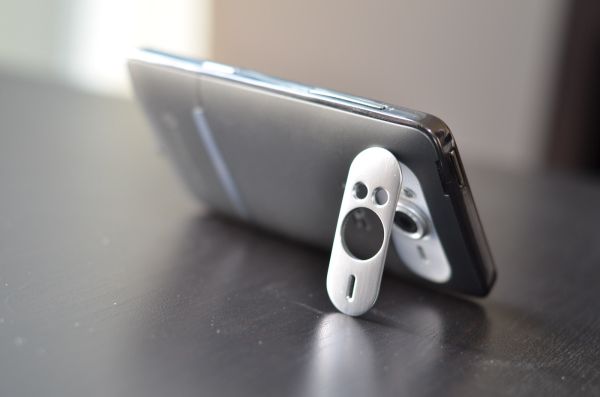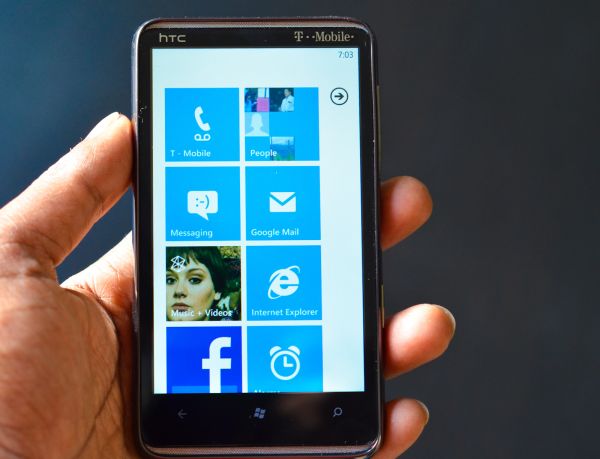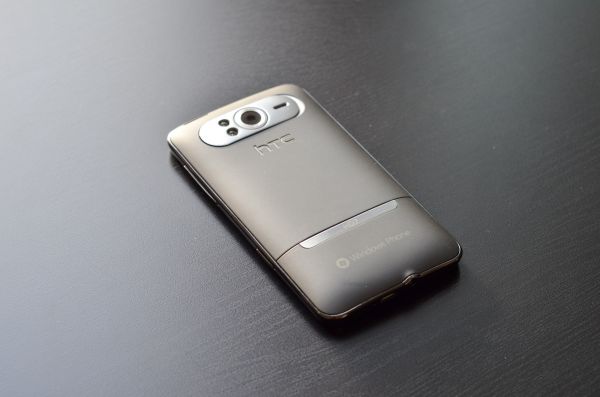HTC HD7: Now With NoDo
by Vivek Gowri on May 12, 2011 6:30 AM EST- Posted in
- Smartphones
- Windows Phone 7
- Snapdragon
- Mobile
- HTC HD7
When Microsoft launched Windows Phone 7 late last year, it was readily evident that they had a solid platform on their hands, but it was missing some critical details. Chief among them? Copy-and-paste, bringing back a frequent grievance from the early iPhone days. The platform’s first update, codenamed “NoDo” (there’s a story behind that), is now out, with copy-paste support in tow, along with much improved application loading and some general performance tune-ups in the UI.
At the same time, we decided to take a look at HTC’s HD7, since it’s been my day-to-day phone for a couple of months now. It’s still the only Windows Phone you’ll find in a T-Mobile store, so it’s worth taking a look at, especially now that a very similar variant is due to hit AT&T in the coming weeks.
Meet the HD7
When HTC launched the HD2 in late 2009, it was one of the most technologically advanced phones on the market, with a 800x480 4.3” display and a 1GHz Qualcomm Snapdragon processor. This was well before everyone had a 1GHz phone—the HD2 was just the second Snapdragon-based device to hit market, after the European Toshiba TG-01, and was the first 1GHz phone on the American market. Unfortunately, for all the amazing hardware, it was saddled with Windows Mobile 6.5. Even with HTC’s advancements to WM (capacitive touch, multitouch, the first implementation of Sense UI) it simply wasn’t a viable platform at the time. A good comparison would be the N8—great hardware running a dead-in-the-water OS.
When Microsoft started releasing details about Windows Phone 7, it became clear that while fully capable of running the new OS, the HD2 would not be getting an upgrade. Microsoft indicated that the button layout did not conform to the guidelines given for WP7 handsets, which was true, but Microsoft really wanted to have a clean break from the previous generation of products, and that left the HD2 in a cold place (officially, at least—XDA and other developers have gotten everything from Froyo to WP7 to Ubuntu and Windows XP running on the HD2). HTC did the next best thing, and relaunched it’s flagship Windows device as the HD7, with 7 indicating it’s status as a WP7 device. In the process, it got a mild ID refresh and a few more features, but overall, it’s very, very similar.
The first noticeable difference is the buttons—the five button array has been replaced by three backlit capacitive buttons—back, Windows, and search, as dictated by the WP7 design guide. The speaker and mic have been expanded to span the width of the device at the top and bottom edges, with an attractive metal grille covering them. The matte plastic on the sides of the phone has been replaced with a dark chrome band, which has an attractive but understated look. It’s much more subtle than normal chrome brightwork.

The curved back of the HD7 is rendered in a mildly rubberized plastic, with a brushed aluminum stand surrounding the camera. The stand, while a clever detail, is not actually that great—like the EVO 4G, it’s prone to tipping over if not on a perfectly level surface, due to the location and shape of the stand itself. I like the Thunderbolt’s stand better, it’s sturdier and works in both portrait and landscape modes. But the biggest problem here is the battery cover. The soft touch plastic is great, but the cover itself feels cheap, and for good reason. The plastic itself is ridiculously thin, and there are large panel gaps—with the battery cover mounted, you can actually see a bit of the SIM card. In addition, the panel gaps let in a lot of dust. It’s a blemish on an otherwise well designed device.
The interesting part hidden in all this is that given HTC’s current lineup, the HD7 feels a little bit last generation. HTC has moved to a very consistent design language across all of it’s devices, as noted by Brian in his Thunderbolt review. It started with the Desire HD, which was an update of the Nexus One/Desire industrial design, and HTC has since expanded the design language to (long list alert!) the Mozart, the Surround, the Trophy, the Thunderbolt, the Sensation, and the Desire S (or the Incredible S for VZW). The HD7 is a holdover from the old days, when HTC had more slab sided designs, with less curves and less metal. Most of the recent HTC designs have basically pointed towards aluminum unibody construction, and the HD7 unashamedly differs from that. I’d expect the next revision of the HD7 to fall much more in line with the rest of HTC’s recent phones, possibly based on the Desire HD chassis.
| Physical Comparison | |||||||||
| HTC HD7 | HTC Surround | LG Optimus 7 | Samsung Focus | Dell Venue Pro | |||||
| Height | 122 mm (4.80") | 119.7 mm (4.71") | 125 mm (4.92") | 122.9 mm (4.84") | 121.0 mm (4.76") | ||||
| Width | 68 mm (2.68") | 61.5 mm (2.42") | 59.8 mm (2.35") | 65 mm (2.56") | 64.4 mm (2.54") | ||||
| Depth | 11.2 mm ( 0.44") | 12.97 mm (0.51") | 11.5 mm (0.45") | 9.9 mm (0.39") | 14.9 mm (0.59") | ||||
| Weight | 162 g (5.71 oz) | 165 grams (5.82 oz) | 157 grams (5.54 oz) | 119 grams (4.2 oz) | 176 grams (6.21 oz) | ||||
| CPU | 1GHz Qualcomm QSD8250 | 1 GHz Qualcomm QSD8250 | 1 GHz Qualcomm QSD8250 | 1 GHz Qualcomm QSD8250 | 1 GHz Qualcomm QSD8250 | ||||
| GPU | Adreno 200 | Adreno 200 | Adreno 200 | Adreno 200 | Adreno 200 | ||||
| RAM | 576MB LPDDR1 (512 system, 64 GPU) | 512 MB LPDDR1 (448 system, 64 GPU) | 512 MB LPDDR1 (448 system, 64 GPU) | 512 MB LPDDR1 (448 system, 64 GPU) | 512 MB LPDDR1 (448 system, 64 GPU) | ||||
| NAND | 16GB integrated | 512 MB integrated, 16 GB (Internal Class 4 microSD) | 16 GB integrated | 8 GB integrated | 8 or 16 GB integrated | ||||
| Camera | 5MP with autofocus, LED flash, 720P video recording | 5 MP with autofocus, LED flash, 720P video recording | 5 MP with autofocus, LED flash, 720P video recording | 5 MP with autofocus, LED flash, 720P video recording | 5 MP with autofocus, LED flash, 720P video recording | ||||
| Screen | 4.3" LCD 800 x 480 | 3.8" LCD 800 x 480 | 3.8" LCD 800 x 480 | 4" Super AMOLED 800 x 480 | 4.1" AMOLED 800 x 480 | ||||
| Battery | Removeable 4.55 Whr | Removable 4.55 Whr | Removable 5.55 Whr | Removable 5.55 Whr |
Removable 5.18 Whr |
||||
At 162 grams (5.7 ounces), the HD7 is a pretty hefty phone, and the size and weight give it a substantial feel in-hand. Battery cover notwithstanding, it feels very well put together and very familiar at the same time. The HD7’s similarities with the EVO and HD2 are not just limited to physical attributes; all three share variants of Qualcomm’s first generation Snapdragon SoC. The GSM-only HD7 has the QSD8250, as with all other WP7-based handsets, to go along with 576MB RAM, 512MB ROM, and a built-in 16GB SD card. It’s no longer cutting edge, but Microsoft is fairly limiting as far as what they allow handset makers to use—you can get a WP7 device with any CPU as long as it’s a 65nm Scorpion, Ford Model T-style. We’ll get to the application performance in a bit, specifically the NoDo update and the performance improvements it brings, but for now, let’s take a look at the display and camera performance.


















44 Comments
View All Comments
damianrobertjones - Thursday, May 12, 2011 - link
I don't want a super resolution phone with S-lcd or two processors...What I DO WANT is a much, much larger battery. I'm sick and tired of charging the thing nearly every single day. Sure, I've lived with the situation since the Qtek days but the HD7 (and HD2) that's in front of me does take the biscuit.
Also, HTC, stop designing the back of your phones so the people in China can't make a suitable cover for their extended batteries. Either do it yourself or design well.
AggHhhhgghg
Crono - Thursday, May 12, 2011 - link
As a Dell Venue Pro owner/user, I have to agree with all the points in this article about Windows Phone 7.In one sense, Microsoft stepped forward with their new phone platform to come close to what Apple has done with iOS, even (dare I say) surpassing Apple with some features and elements of the GUI.
But they have done so by limiting the options available. It's as if Microsoft gave up the "Windows" aspect and really just went the Apple route, albeit in their own way. Microsoft has always been apt to learn from/copy the innovations of other companies, but it seems like they gave up a bit much in recreating a Windows branded platform over the ashes of the old Windows Mobile. I find it odd that Google's Android OS is more akin to Windows than WP7 is. I miss the "power" options that the Windows Mobile/CE phones and PDAs had, like the ability to close and switch between apps and the ability to overclock/underclock with an application, among other things.
Trefugl - Thursday, May 12, 2011 - link
I don't find it odd that Android is "more akin to Windows than WP7" assuming that you are referring to the openness/scalability and "power user" aspects. Google comes from a Linux mindset, and Linux has always been that way... what is amazing is that Google has managed to polish Android to the point that the average user finds it accessible (much like they do Windows).I always hoped that Microsoft could find a balance between Google and Apple's approaches, but they are still just too far behind. At this rate, Google will manage to provide an appropriately structured environment for their userbase before WP7 is relevant in terms of market share and features. (This comes from a guy who had high hopes for WP7)
Flunk - Thursday, May 12, 2011 - link
I have an HTC HD7 and I can see your point. Windows Phone 7 is more of an offshoot of Xbox and Zune than a successor to Windows Mobile. It's not designed to be the most flexible pocket computer it can be but instead focuses on doing common tasks well and quickly.I used to use Windows Mobile and I think this is the way to go for a phone. Sure I can't use it to code Java programs, but it's much better at things I normally use my phone for.
Stuka87 - Thursday, May 12, 2011 - link
For the Black level, isn't lower better? This graph seems to the opposite of the ones we normally see.Spivonious - Thursday, May 12, 2011 - link
I just wanted to point out that "NoDo" was done in January. It was carrier testing that has delayed it.For other readers, watch the videos from this year's MiX to see what Mango contains. If MS really puts some marketing muscle behind it, it really has a good chance of knocking the iPhone out of second place.
Stuka87 - Thursday, May 12, 2011 - link
You are aware that the iPhone is in first place right? Well, unless you compare all Android devices against the single iPhone device (rather than iOS devices).But even if you do measure it incorrectly like that, WP7 would need to have the single largest sales increase of any device in history to even get close to Android or iOS.
duffman55 - Thursday, May 12, 2011 - link
It's trivial to compare the number of users of an individual smartphone model, unless you're going to be holding some sort of smartphone popularity contest.What's important is the number of users of the OS. Developers are more likely to develop for a platform with more users.
You're right, WP7 does have a ways to go to compete with the likes of Apple and Google. It's going to be a while, but I think they'll get there eventually.
Vivek, I noticed "it's" was used where it should have been "its" a few times in the article. I don't mean to nitpick, just letting you know :)
VivekGowri - Friday, May 13, 2011 - link
Really? I'm usually better about that. Damn English grammar, lol.earle36 - Thursday, May 12, 2011 - link
I really have to disagree with part of the conclusion here... I have been using a Samsung Focus for several months and love the OS. I don't need custom ring tones - sure its 2011 and they don't offer custom ring tones - big deal. I'd rather they focus on ACTUAL core OS improvements rather than extras like custom ring tones. And mango will offer several improvements to the OS. Within one year they will have added copy paste, improved app loading, new browser, multitasking, messenger integration, and so on. That is huge. I understand that they are just playing catch up - but that's what happens when you release a completely new mobile OS. Several months ago Anandtech published reviews of the WP7 devices and and the WP7 OS - knowing full well what it did and didn't offer, and what the next year was to offer. The reviews were very positive when looking at the big picture. Fast forward to today, MS has delivered exactly what they said they would and (as of now) are on track to deliver some MAJOR improvements to the OS, and now its not enough? What changed?